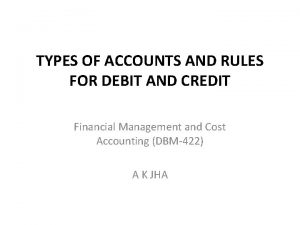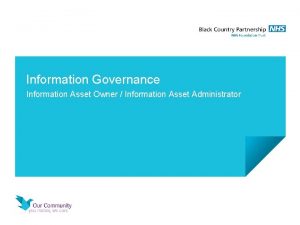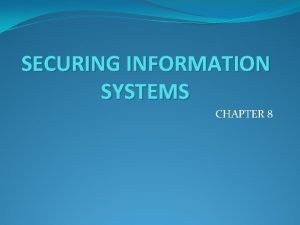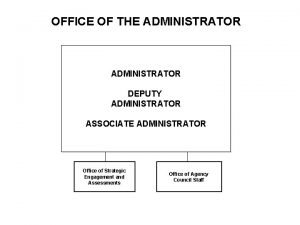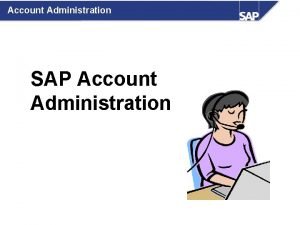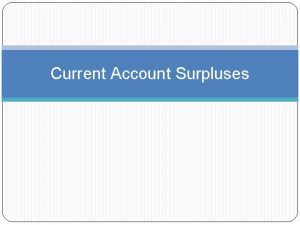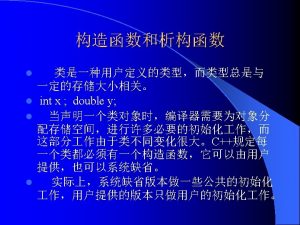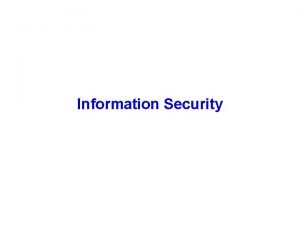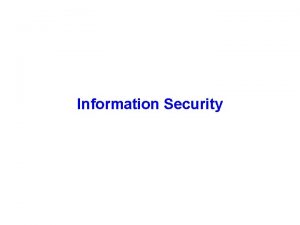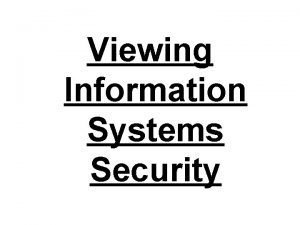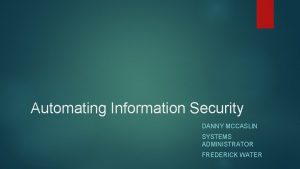INFORMATION SECURITY SYSTEMS Practical Lecture 2 Administrator Account









- Slides: 9

INFORMATION SECURITY SYSTEMS Practical Lecture # 2 (Administrator Account & Passwords Rules) By: Fatimah Said Al-Hafiz.

OBJECTIVES Understand the concepts behind a strong password. Part 1: Explore the concepts behind creating a strong password. Part 2: Explore the concepts behind securely storing your passwords? COMPUTER SECURITY SYSTEM LECT#2 2

PART 1: CREATING A STRONG PASSWORD Strong passwords have four main requirements listed in order of importance: 1) The user can easily remember the password. 2) It is not trivial for any other person to guess a password. 3) It is not trivial for a program to guess or discover a password. 4) Must be complex, containing numbers, symbols and a mix of upper case and lower case letters. COMPUTER SECURITY SYSTEM LECT#2 3

PART 1: CREATING A STRONG PASSWORD (CONT. ) sample password policy set for a typical organization: • The password must be at least 8 characters long • The password must contain upper- and lower-case letters • The password must contain a number • The password must contain a non-alphanumeric character COMPUTER SECURITY SYSTEM LECT#2 4

PART 1: CREATING A STRONG PASSWORD (CONT. ) • A good way to create strong passwords is to choose four or more random words and string them together. • Example: • The password televisionfrogbootschurch is stronger than J 0 n@than#81. • Notice: that while the second password is in compliance with the policies described above, password cracker programs are very efficient at guessing that type of password. • While many password policy sets will not accept the first password, televisionfrogbootschurch, it is much stronger than the second. • It is easier for the user to remember , it is very long and its random factor makes it hard for password crackers to guess it. COMPUTER SECURITY SYSTEM LECT#2 5

ONLINE PRACTICAL (AT HOME) • Using an online password creation tool, create passwords based on the common company password policy set described above. a. Open a web browser and go to http: //passwordsgenerator. net b. Select the options to conform to password policy set c. Generate the password. • Is the password generated easy to remember? • _____________________. Using an online password creation tool, create passwords based on random words. Notice that because the words are appended together, they are not seen as dictionary words. d. Open a web browser and go to http: //preshing. com/20110811/xkcd-password-generator/ e. Generate a random word password by clicking Generate Another! at the top portion of the webpage. f. Is the password generated easy to remember? _____________________. COMPUTER SECURITY SYSTEM LECT#2 6

PRACTICAL LAB • Add password in any file of MS files. Go to file> Protect> Encrypt by password. Set your password and save the changes. • Restrict the access to your document. Go to file> Protect> Restrict the access. Set your password and save the changes. Add digital signature to your document. Go to file> Protect> add digital Signature. Set your sign and write your name to applay. COMPUTER SECURITY SYSTEM LECT#2 7

ONLINE PRACTICAL (AT HOME) A popular password manager is Last Pass. Create a trial Lastpass account: a. Open a web browser and go to https: //lastpass. com/ b. Click Start Trial to create a trial account. c. Fill out the fields, as instructed. d. Set a master password. This password gives you access to your Last. Pass account. e. Download and install the Last. Pass’ client for your operating system. f. Open the client and log in with your Last. Pass master password. g. Explore Last. Pass password manager. COMPUTER SECURITY SYSTEM LECT#2 8

ANSWER THE QUESTIONS • Besides you, at least one other entity has access to your passwords. Who is that entity? _______________________________. • While having all your passwords stored on the same place can be convenient, there are drawbacks. Can you think of any? ______________________________. • As you add passwords to Lastpass, where are the passwords stored? ______________________________. COMPUTER SECURITY SYSTEM LECT#2 9
 Dr and cr rules
Dr and cr rules Ec-council network security administrator
Ec-council network security administrator Privat security
Privat security Information asset administrator
Information asset administrator Eurocode 2 lap length table
Eurocode 2 lap length table Explain about visa international security mode
Explain about visa international security mode Cnss security model คือ
Cnss security model คือ 01:640:244 lecture notes - lecture 15: plat, idah, farad
01:640:244 lecture notes - lecture 15: plat, idah, farad Securing information systems summary
Securing information systems summary Accounts receivable on a balance sheet
Accounts receivable on a balance sheet
